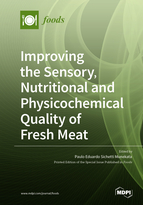Improving the Sensory, Nutritional and Physicochemical Quality of Fresh Meat
A special issue of Foods (ISSN 2304-8158). This special issue belongs to the section "Meat".
Deadline for manuscript submissions: closed (30 June 2021) | Viewed by 21001
Special Issue Editor
Interests: meat production; meat quality; lipid oxidation; natural antioxidants; phenolic compounds
Special Issues, Collections and Topics in MDPI journals
Special Issue Information
Dear Colleagues,
Meat is one of the main components in the modern diet. The high nutritional value (proteins, essential amino acids, and vitamins) and pleasant sensory attributes (e.g., “juicy” and “tender”) used to describe meat in most cases support its importance among consumers when buying food and preparing meals. Additionally, the increasing per capita consumption and the growing number of consumers willing to pay for high-quality meat in the last decades have strengthened the share of meat in the present and future food market. However, improving these prized characteristics is a complex task that involves many factors. In terms of animal production, feeding, handling, and slaughtering must be properly carried out to ensure the high quality of fresh meat. The further steps in meat production, processing and aging of muscles, are equally crucial for the successful and continuous commercialization of fresh meat. New strategies, feeding components, and technologies to improve the physicochemical characteristics, nutritional value, and sensory attributes of fresh meat are currently under evaluation to improve the quality of fresh meat.
Aim and Scope: Researchers are invited to submit original research and systematic reviews that aim to advance the knowledge about the influence of feeding composition, housing, handling, slaughtering and processing technologies, and approaches to improve the quality of fresh meat (with the main focus on sensory attributes, nutritional value, and physicochemical characteristics). All meat-producing animals will be considered in this Special Issue.
We are inviting submissions on the following topics:
- New feeding components to enhance the sensory, nutritional, and physicochemical characteristics of fresh meat;
- Advances in handling and slaughtering to improve the quality of fresh meat;
- Innovative and alternative approaches and technologies in the processing and aging of fresh meat;
- Sensory and consumer studies about fresh meat;
- Active packaging to improve the shelf life of fresh meat.
Dr. Paulo Eduardo Sichetti Munekata
Guest Editor
Manuscript Submission Information
Manuscripts should be submitted online at www.mdpi.com by registering and logging in to this website. Once you are registered, click here to go to the submission form. Manuscripts can be submitted until the deadline. All submissions that pass pre-check are peer-reviewed. Accepted papers will be published continuously in the journal (as soon as accepted) and will be listed together on the special issue website. Research articles, review articles as well as short communications are invited. For planned papers, a title and short abstract (about 100 words) can be sent to the Editorial Office for announcement on this website.
Submitted manuscripts should not have been published previously, nor be under consideration for publication elsewhere (except conference proceedings papers). All manuscripts are thoroughly refereed through a single-blind peer-review process. A guide for authors and other relevant information for submission of manuscripts is available on the Instructions for Authors page. Foods is an international peer-reviewed open access semimonthly journal published by MDPI.
Please visit the Instructions for Authors page before submitting a manuscript. The Article Processing Charge (APC) for publication in this open access journal is 2900 CHF (Swiss Francs). Submitted papers should be well formatted and use good English. Authors may use MDPI's English editing service prior to publication or during author revisions.
Keywords
- Feeding components
- Natural antioxidants
- Animal production
- Meat aging
- Sensory attributes
- Nutritional value
- Color Tenderness
- Flavor Active packaging
- Volatile compounds







